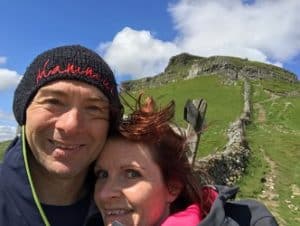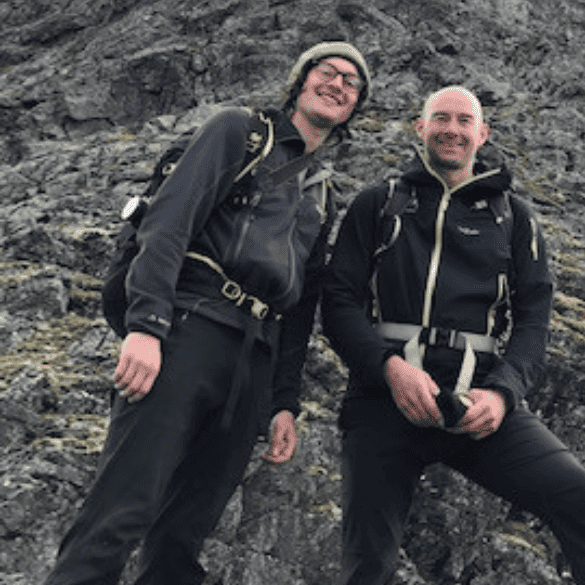John Leather suffered a life changing spinal cord injury when he was knocked from his bicycle in July 2019. The accident resulted in him sustaining a complicated fracture to his right shoulder and paralysis from T7 (from the bottom of his ribcage). This case study, written in January 2020, provides an account of his rehabilitation journey so far and his hopes for the future.
Bicycle accident resulting in Spinal Cord Injury
 “Prior to my accident I was a keen climber and hill walker, my son was my climbing partner and my wife my walking partner. Tom and I climbed anything, anywhere but mainly at indoor climbing walls. My wife and I spent a lot of time walking in the Lake District and had completed 96 of the 214 Wainwright’s. Cycling was a recent hobby used to keep myself fit”.
“Prior to my accident I was a keen climber and hill walker, my son was my climbing partner and my wife my walking partner. Tom and I climbed anything, anywhere but mainly at indoor climbing walls. My wife and I spent a lot of time walking in the Lake District and had completed 96 of the 214 Wainwright’s. Cycling was a recent hobby used to keep myself fit”.
John was aged 50 when he was knocked off his bicycle after being struck by a car that turned right across his path. He was rushed to Leeds General Infirmary where surgery was performed to stabilise his spine, followed by a further two surgeries to pin and plate his broken shoulder blade. After two weeks in Intensive Care he was then transferred to the Spinal Injuries Unit at Pinderfields Hospital where he remained for 13 weeks.
In September 2019, John moved to STEPS Rehabilitation as a residential client after his solicitors (Stewarts), secured funding to pay for his specialist rehabilitation. On arrival, John was not able to sit up, wash himself or get dressed unaided, nor was he able to manage his bladder and bowel regime. After an initial medical and rehabilitation assessment, a unique rehabilitation care plan was drawn up using a combination of therapies all delivered on-site at STEPS.
“I like the fact that everyone at STEPS works as a team for me…. they are always talking together about me…about my progress and the next stages of my rehabilitation. The different therapists and experts don’t operate as separate departments, it’s very much a team effort and ethos. Everyone I meet, from the nursing team, the physios and the occupational therapists, work together to deliver the very best rehabilitation programme possible. It’s all about me as a client, and the benefits of this approach can be seen in my progress so far.”
Spinal Injury Rehabilitation
John’s rehabilitation journey began with making it a priority to build up the strength and movement in his badly injured shoulder and upper body to give him the ability to start to manage his spinal injury. Through gym work with physiotherapists, hydrotherapy and intensive soft tissue massage, John has improved the muscle strength and flexibility in his upper body, enabling him to sit up unaided and to transfer from his chair to bed. “I can now wash and dress myself…things that at one point I thought would be impossible. The fact I’m able to properly manage my personal hygiene means I’ve regained my dignity – I feel I’ve moved up to the next level in my rehabilitation. Each step that I take in my rehabilitation journey is hugely significant.”
The improvements to John’s condition have required perseverance and dedication on his part, the same qualities that enabled him to be a skilful climber. “The team at STEPS set me small achievable goals which helps hugely with the way I psychologically approach my rehabilitation. Being able to smash those goals and have new ones set makes the rehab process very much a team effort. They like the fact that that I’m trying my very best, but the truth is, I’m trying because they are trying too!”
Despite his cycling accident John loves the time he spends on the FES bike - as of December 2019 he was cycling 8 miles a day. FES cycling applies small electrical pulses to paralysed muscles to restore and improve their function. It has helped John to improve his bone density, circulation and ease muscle spasms.
“The rehabilitation assistants are the glue that bonds STEPS together. Initially they washed and dressed me, assisted the nurses with my care and helped me with my independent therapies. As I slowly progressed they began to back off and allow and encourage me to be more independent but with the reassurance that they were always there if needed. Their enthusiasm and positivity is infectious, they are proactive in their work and no job is too small or insignificant if it helps me to get through each day and night.”
Residential Spinal Rehabilitation
After a few months in his own en suite room at STEPS, John has now moved to the apartment within the STEPS building. Having his own living space immediately brought John a sense of independence, and gave him a much-needed home-from-home environment. “As soon as I came through the doors of STEPS I knew I was in the very best possible place to get the rehabilitation I need to physically and mentally manage my injuries. Most importantly…I knew that the primary focus was on getting me to a position where I can go home.”
Not being at home is something that John has struggled with since his accident. Over the past few years John and his wife, Lisa, have extensively renovated their 1870’s home. They currently have plans submitted with their local council to build an extension, which will enable him to return home. “The plans have actually been modelled on my room at STEPS. I’m also a very keen gardener so I’d like to get the outdoor space around the house adapted to enable me to do some gardening from my wheelchair.”
STEPS has also given John a community of people in a similar position to him. “The communal restaurant and social area make it easy to be part of the STEPS community. I was very quickly welcomed and when I see new people arrive, I try to do the same. There are always activities taking place to keep you occupied, but equally, if I want time on my own, I have my own living space, which is a safe haven for my family and me. The fact that Lisa can stay with me gives me some sense of normality.”
What next?
“I’ve always been a methodical person, so I carefully reflect on everything that the STEPS’ team tell me to do. I try not to think too far ahead, but even after these few months I can see how far I’ve come, and I feel very proud of what I’ve achieved. The focus is on “getting John home”. I hope that this will be in Spring 2020 once the adaptation work has been carried out on our house to allow me to live as independently as possible.”
